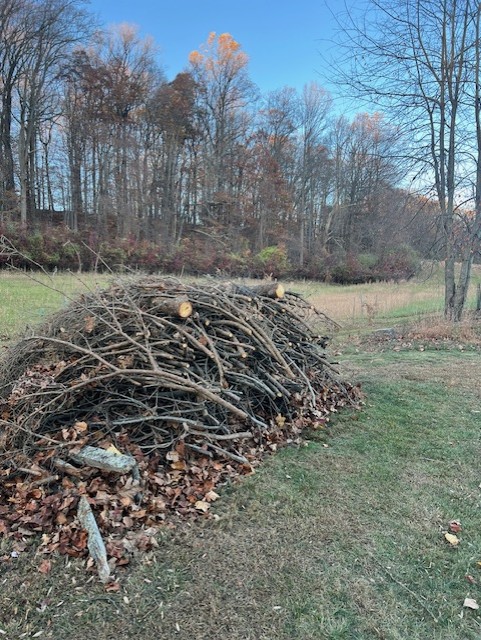Written by ROR Member Mark Eberhardt, Principal, MSE Landscape Associates, LLC.
Your personal naturalized landscape or any public garden space can not only be beautiful in winter, but also can be functional to the ecosystem. Gone are the days of cutting back our gardens around Thanksgiving and calling it a season. With ecologically sensitive plantings, a naturalized landscape continues to provide beauty, food and habitat, even in winter.
Think of a beautiful natural winter landscape and what it looks like and also provides. This is our guide on how to practice winter preparation management. The stark beauty of a bare deciduous tree, sometimes with snow clinging to every branch and bud, sometimes glittering in the morning sun after a glaze of freezing rain. Snow covered or bare evergreens, offering a deep green contrast to the sometimes brown of snowless winter landscapes. Snow capped or frosty shrubs and herbaceous plants, glittering in the late afternoon sun, and grasses moving with the winter winds. Bright berries and seed heads lighting up a dreary day and feeding the birds and small mammals. 
When we create natural landscapes, we start to build an ecosystem of beneficial insects, birds, small mammals, and yes, even those pesky deer (more on that later). As stewards of the land that we control, we need to be aware that these creatures require the natural landscape for winter survival, food, habitat and cover from weather and storms. Let’s explore some management techniques that are mindful of these important elements, that have also largely been disregarded in traditional landscape management of years gone by. Leaves: Let them lay. Or, shred them, store them and use them for organic mulch or soil enrichment. This is counterintuitive to so many practitioners and gardeners who have been conditioned to wipe leaves clean and dispose of them, sometimes even in plastic bags picked up by garbage collectors. Leaves are nature’s way of restoring and maintaining soil health. They also provide winter habitat to larvae and eggs of many beneficial insects, such as fireflies which are a poster child for the precipitous decline in beneficial insects. One reason is that we strip their habitat and their opportunities to reproduce in favor of a ‘clean’ landscape. The leaves also provide a natural mulch for plants, helping protect them from harsh freezing conditions and offering absorption of winter rains.
Leaves: Let them lay. Or, shred them, store them and use them for organic mulch or soil enrichment. This is counterintuitive to so many practitioners and gardeners who have been conditioned to wipe leaves clean and dispose of them, sometimes even in plastic bags picked up by garbage collectors. Leaves are nature’s way of restoring and maintaining soil health. They also provide winter habitat to larvae and eggs of many beneficial insects, such as fireflies which are a poster child for the precipitous decline in beneficial insects. One reason is that we strip their habitat and their opportunities to reproduce in favor of a ‘clean’ landscape. The leaves also provide a natural mulch for plants, helping protect them from harsh freezing conditions and offering absorption of winter rains.
Perennials, Ground Covers and Grasses: Don’t cut them back. The seed heads provide much needed food and nourishment for our winter birds. There are many beneficial insects that overwinter or lay their eggs in the stems and leaves of perennials and grasses. It is actually best to cut those back shortly before new foliage emerges in spring (varies from plant to plant). The aesthetic value can be very pleasing, watching the plants take their winter color, sometimes covered in snow, frost or ice. If you do choose to cut back some perennials, let the seed heads lay near the base of the plant for self proliferation opportunities.
Shrubs: There are many native shrubs that bear fruit in the fall, which provide an important food source for birds and small mammals. Winter is an excellent time to prune shrubs (and trees), but limit your pruning to the structural, and leave the berries. Evergreen shrubs will also act as a natural thermometer, as their leaves fold when it is below freezing.
Trees: Trees can shine in the winter. Beautiful bark, berries, and structure take center stage. Evergreens provide necessary refuge and protection for birds and small animals. White oaks, beeches and other native species have persistent leaves that stay on all winter and provide overwintering opportunities for many species of lepidoptera and other insects. Like shrubs, trees can be structurally pruned in the winter. Pile up the branches since they provide shelter for birds and small animals, and habitat for overwintering insects.
Deer Protection: Due to the exploding deer population, it has become very important to protect plants and especially small trees from deer browsing and buck rubs. For buck rubs, they tend to target smaller, younger trees and shrubs. As trees and shrubs mature, they become less susceptible to deer and you can ‘graduate’ them from protection. There are many techniques, some better than others, to protect your plants. Fencing them in or providing trunk guards are the favored techniques. As far as deer browsing (herbivory), we have learned that observation is your most powerful tool as far as what they eat and don’t eat, which should greatly impact your plant palette when you decide what to plant. Planting beds that get browsed can also be fenced in. Normally, spring will provide more natural food sources in the fragmented woodlands, and you can remove your deer protection until next Sept-Oct.
Watering: Be aware of what Mother Nature provides in terms of rainfall in the fall. Plants, particularly broad leaved evergreens store up on water to sustain them through winter months. While the plants are going into dormancy, it is a good practice to make sure they are well watered prior to the colder months where frozen soil limits their water uptake.
In conclusion, winter is still a vibrant, active time for the natural landscape. Hopefully following some of these guidelines will help extend your enjoyment of your naturalized landscape, while providing important function for the ecosystem that comes with it.

